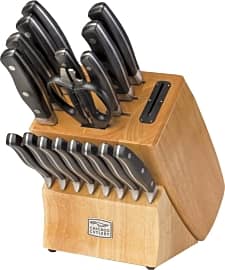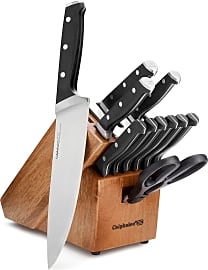The 10 Best Self Sharpening Knives

This wiki has been updated 35 times since it was first published in December of 2016. Dull kitchen knives are not only difficult to use, they can also be dangerous, because they require you to use more force to cut through foods. But not every cook has the time to hone their blades before preparing each meal. These self-sharpening options will cut down on the time you need to spend on upkeep, and they're available in many different styles and priced for a variety of budgets. When users buy our independently chosen editorial choices, we may earn commissions to help fund the Wiki.
Editor's Notes
November 24, 2020:
Most self-sharpening knives on the market come from the same handful of brands, but we did find one newer option that we felt offered an intriguing value: the Starfrit Set Of 4, which includes a traditional chef's knife and a Santoku-style chopper as well as a utility knife and a parer, all bundled together for a fairly affordable price. It's also far and away the most colorful entry on the list, making it a great choice for users who aren't crazy about the more common metal-and-wood aesthetic. We also added the Sabatier Stainless Steel, an alternative to the Sabatier Forged for those who prefer the feel of a rounded handle.
To make room for these additions, we trimmed a couple of options that we felt didn't offer enough value to justify their price. The Calphalon 15-Piece had fewer knives and fewer sharpening inserts than the J.A. Henckels Modernist (which remains the clear standout choice), making it basically redundant despite its higher cost. And a number of customers reported that the Sabatier Pro picked up corrosion quite easily - in some cases arriving with rust spots right out of the box. It also lacked any serrated blades, which is a somewhat frustrating omission in what should be an all-in-one set. We'd recommend the Farberware 13-Piece for those interested in an affordable but still versatile collection.
If you do purchase one of the options that includes a sheath rather than a knife block, you may want to pair it with a magnetic bar or stand to let you quickly stow and retrieve your blades while cooking. Or, if you decide you'd prefer to keep your edges honed the traditional way, you can check out our lists of the best whetstones and sharpening steels.
July 07, 2019:
Just as stylish as it is functional, the J.A. Henckels Modernist features an all-steel construction with satin-finished handles and mirror polished end caps. The blades have full bolsters, making them very well-balanced, and, unlike most other high-end knives, they're dishwasher-safe. The Calphalon 15-Piece includes just about everything you'll need for most culinary tasks. Its larger blades are forged from high-carbon German steel, while the steak knives are stamped from Asian steel, and their full tang construction makes them strong and durable. If you're short on counter space, consider the Calphalon Precision, which comes with a slender, space-saving block. The handles are heavy enough to tackle tough jobs, and the ergonomic grips make them comfortable to hold, even for long durations.
If you don't want a full set, or don't have enough space for a storage block, the Wiltshire StaySharp is a set of two that includes a 6-inch Santoku and a 5-inch utility knife. Each one has a plastic sheath with a built-in sharpener that makes honing simple and protects the blade from damage, and they lock into place for safe storage. The Farberware EdgeKeeper is a similar option that comes in eight styles, from a 3.5-inch paring knife to an 8-inch chef knife, and they're very affordably priced. The handles are very lightweight, so they won't fatigue your hands, but they're not the best choice for heavy-duty jobs. The Sabatier Forged also come with self-sharpening sheaths, and, in addition to seven different blade types, you can get a set of all-purpose kitchen shears. However, they can be difficult to slide in and out of the covers, so you'll need to be extra careful to avoid cutting your hands.
A Brief History Of Knives
Today, there are knives for just about every purpose and occasion, so you can always be sure to have the right tool for the job.
Knives are such ubiquitous tools that it may seem like they've been around forever, but the fact is that they've only been around about 2.5 million years (give or take).
Early precursors to Homo sapiens used sharpened chunks of rock, bone, obsidian, or flint as both tools and weapons, although these early blades weren't particularly user-friendly or terribly durable.
When humans hit the scene about 315,000 years ago, they began to refine both the edges and handles, using flint because it was easy to re-work the blade as it became worn.
At this point, these tools were used solely as weapons and as a way to rip flesh off of a kill. It wouldn't take its place as a common dining utensil until the delicious-sounding Bourbon Dynasty came along in 16th century France. Of course, this new breakthrough brought with it new challenges: namely, the fact that knives are sharp and people in the 16th century were often drunk.
As the fork had yet to grow in popularity, diners of the time used the knife to both cut their food and deliver it to their mouths, but since much of their hydration came in the form of booze, accidents were unavoidable. It got so bad, in fact, that Louis XIV banned sharp blades from the table, replacing them with blunter versions — the precursors to the modern butter knife.
Once the fork came along, the dining set was more or less formalized: a knife, fork, and spoon. With the advent of stainless steel in the 20th century, however, it became more economically feasible to have a variety of blades in the kitchen, including butter knives, steak knives, and all sorts of chef's blades.
Today, there are knives for just about every purpose and occasion, so you can always be sure to have the right tool for the job. One thing remains constant, however: getting super drunk and trying to feed yourself with a razor-sharp blade is a bad idea.
Benefits Of A Self-Sharpening Knife
A knife is only as good as the edge on it, but keeping that edge sharp has traditionally been a pain. You can use a whetstone, honing rod, or dedicated sharpener, but doing so only gives you one more chore to add to your ever-growing list.
Self-sharpening models, on the other hand, have sharpeners built-in to the block or holder, so that every time you pull out a knife, you drag it along the honing surface, keeping everything in tip-top shape without requiring any special maintenance.
A knife is only as good as the edge on it, but keeping that edge sharp has traditionally been a pain.
This is important, because a dull blade is one that's more likely to injure you. However, many people never think to take the time to maintain their instruments, and so find themselves using dangerous tools quite by accident. Moreover, if your knife is always keen, it will make your kitchen chores go much more smoothly. The time it takes to sharpen a blade more than pays off in time saved during prep work.
That's not to say that you shouldn't occasionally give a self-sharpening knife some TLC, however. Be sure to store it in a block or, at the very least, a sheath when it's not in use, as this will protect the blade (and your digits) from damage.
Once you've experienced the convenience of a self-sharpening knife, chances are you'll never go back to the old-fashioned variety — because if you do, you might as well trade in your washer and dryer for a large basin and clothes wringer while you're at it, you lousy hipster.
How To Handle Your Blade Like A Pro
Beyond being able to flip an omelette one-handed, there are few kitchen skills that are as impressive as being masterful with a blade. Below are a few knife-wielding tips that will make you the envy of any guests who stop by for dinner.
The first thing you should do is properly prepare your cooking station. Keep everything neat and tidy, so that you have room to work. You should also take this opportunity to secure your cutting board by placing a towel or non-slip mat under it — after all, if it moves at the wrong time, the only thing you'll be cutting is the line at the emergency room.
Below are a few knife-wielding tips that will make you the envy of any guests who stop by for dinner.
Place the knife in your dominant hand, with your fingers choked up on the handle and your thumb and index finger on either side of the blade. This gives you a tremendous amount of control over the chopping action, while also keeping all your flesh clear of the sharp parts.
Meanwhile, don't ignore the other hand, as it's the one that truly has skin in the game — or doesn't, if you do things properly. Use what's known as "the bear claw" to hold whatever it is you're cutting. This entails curling the tips of your fingers under your knuckles, and using the knuckles as a guide.
For rapid chopping, on the other hand, you'll want to roll the knife instead of picking it up and bringing it down every time. This means holding the end down with your non-dominant hand, while using the other to lower the knife in a hinge motion.
The most important thing to keep in mind during all of this is that speed isn't worth sacrificing safety. After all, cooking should be fun and rewarding, so enjoy it and don't rush. If you don't end up looking like a star chef from the Food Network, that's okay — so long as you don't end up looking like Captain Hook instead.















